Document 10540775
advertisement
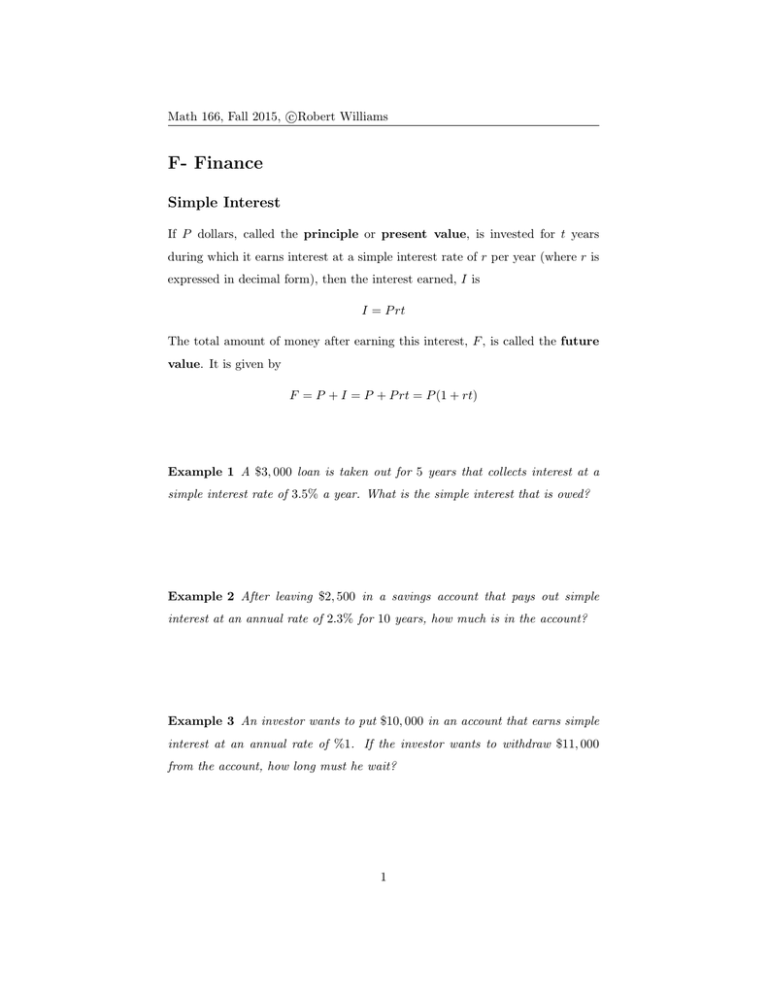
c Math 166, Fall 2015, Robert Williams F- Finance Simple Interest If P dollars, called the principle or present value, is invested for t years during which it earns interest at a simple interest rate of r per year (where r is expressed in decimal form), then the interest earned, I is I = P rt The total amount of money after earning this interest, F , is called the future value. It is given by F = P + I = P + P rt = P (1 + rt) Example 1 A $3, 000 loan is taken out for 5 years that collects interest at a simple interest rate of 3.5% a year. What is the simple interest that is owed? Example 2 After leaving $2, 500 in a savings account that pays out simple interest at an annual rate of 2.3% for 10 years, how much is in the account? Example 3 An investor wants to put $10, 000 in an account that earns simple interest at an annual rate of %1. If the investor wants to withdraw $11, 000 from the account, how long must he wait? 1 c Math 166, Fall 2015, Robert Williams Example 4 A client borrowed $30, 000 at some annual simple interest rate, and after 9 months he paid back $30, 125. What was the interest rate for his loan? Compound Interest Suppose P dollars earn interest at an annual rate of r and the interest is compounded m times per year. After t years, the accumulated amount (or future value) is r F =P 1+ m mt For problems involving compound interest, we will use the TVM solver in your calculator. Be cautious, as the TVM solver will not calculate simple interest. Access the TVM solver by going to APPS, select Finance, and then TVM Solver. (On the TI-83 (not plus), the Finance menu is accessed by pressing 2nd x−1 ) • N= the total number of interest compoundings = m ∗ t • I%= the interest rate per year as a percentage • PV= the present value of the account • PMT= fixed payment made to the account each period • FV= the future value of the account • P/Y= for our class, this will always be the same as C/Y • C/Y= the number of compoundings per year • PMT: for our class, this will always be END In your calculator, after you fill in all of the given values, move the cursor to the value you want to calculate, then press ALPHA ENTER. 2 c Math 166, Fall 2015, Robert Williams Important: The values for PV, PMT, and FV can be negative or positive to represent which direction money is flowing from the perspective of the investor/borrower. A negative number represents outflow- money is being lost by the investor/borrower. A positive number represents inflow- money that is gained by the investor/borrower. Example 5 When Clara graduates from high school, her aunt gives her a bond for $50, 000 that matures in 20 years. If the bond is in a bank account that earns an annual interest rate of 2.8% compounded monthly, what is the present value of Clara’s gift? N= I%= PV= PMT= FV= P/Y=C/Y= Example 6 Stephen took out a loan for $100, 000 that, after 2 years, has a value of $ − 115567.40 (i.e. the client owes the bank $115567.40). If the bank is compounding the interest on the loan quarterly, what is the annual interest rate on the loan? N= I%= PV= PMT= FV= P/Y=C/Y= Example 7 Jenna left $500 in a savings account that earns an annual interest rate of 1.8% compounded monthly. After some time, she discovers that her account has $587.86 in it. How long was the money in the bank account? N= I%= PV= PMT= FV= P/Y=C/Y= 3 c Math 166, Fall 2015, Robert Williams Example 8 Find the amount of money in an account after 10 years if the account was opened with a deposit of $1, 000 and earns 3.1% annual interest compounded N= I%= PV= PMT= FV= P/Y=C/Y= 1. Annually 2. Monthly 3. Weekly If P dollars is invested into an account that earns interest at an annual rate of r (written in decimal form) compounded continuously, then after t years, it will have a value of F = P ert = P · exp(rt) How much money is in the account from example 8 if the interest is compounded continuously? 4 c Math 166, Fall 2015, Robert Williams The annual interest rate that is offered is called the nominal rate. Since different institutions may compound this interest at different intervals, it can be difficult to tell which institution offers the best deal without a little bit of work. We can compare rates by calculating the effective annual yield, that is the simple interest rate that would yield the same amount of interest after one year. We can calculate this with our calculators by going to Eff in the Finance menu. If I is the annual interest rate (as a percent) and m is the number of times it is compounded in a year, then effective annual yield = Eff(I, m) Example 9 If bank A offers an interest rate of 3.7% compounded semi-annually, bank B offers an interest rate of 3.5% compounded monthly, and bank C offers an interest rate of 3.6% compounded quarterly, then which bank would be best for opening a savings account? Which would be best for taking out a loan? Annuities, Sinking Funds, and Ammortization An annuity is a sequence of equal payments made at equal time periods, typically once per compounding cycle. For this class, we will always assume that the payments are made at the end of each compounding cycle. When this process is used to pay off a debt, it is called amortizing the debt. A sinking fund is an account established to accumulate funds to meet some future need. Like with annuities, we will assume that sinking funds involve depositing equal payments at the end of each compounding cycle. The amount of money accumulated into a sinking fund is called equity. 5 c Math 166, Fall 2015, Robert Williams Example 10 A family decides that they want to save up for a vacation and have agreed to set aside $250 a month for their trip. If they deposit the money at the end of each month into a savings account with an annual interest rate of 4.8% compounded monthly, how much will they have available in their travel fund after five years? N= I%= PV= PMT= FV= P/Y=C/Y= Example 11 New parents decide to start a college fund for their child. If they wish to have $50, 000 in the savings account at the end of 18 years and they find a savings account that has an interest rate of 3.8% compounded quarterly N= I%= PV= PMT= FV= P/Y=C/Y= 1. How much should be deposited at the end of every quarter? 2. How much interest would the account earn over its lifetime? 3. What is the value of the account after 9 years? 4. How much interest does the account earn in the first quarter of the 10th year? 6 c Math 166, Fall 2015, Robert Williams Example 12 A credit card with an outstanding balance of $2, 500 has an annual interest rate of 13.2% compounded monthly. N= I%= PV= PMT= FV= P/Y=C/Y= 1. If the cardholder sends in monthly payments of $100 and makes no further purchases, how long will it take to pay off the card? 2. If the cardholder wants to completely repay this loan in 2 years, how much should be paid monthly? Example 13 After winning the state lottery, the state gives you two options. You can either accept a lump sum of $4.5 million now, or the state will pay out $6 million as $50, 000 monthly payments for the next 10 years out of an account with an annual interest rate of 7.2% that compounds monthly. Which option should you choose? N= I%= PV= PMT= FV= P/Y=C/Y= 7 c Math 166, Fall 2015, Robert Williams Example 14 A corporation wishes to increase productivity by purchasing new machinery. One machine costs $120, 000, it will save the corporation $25, 000 a year, and is expected to last eight years. A different machine costs $170, 000, will save the corporation $30, 000 a year, and is expected to last nine years. If the corporation uses an annual interest rate of 8% to project its spendings, which machine should they pruchase? N= I%= PV= PMT= FV= P/Y=C/Y= N= I%= PV= PMT= FV= P/Y=C/Y= Example 15 Find the amortization table for a $25, 000 loan amortized in six semi-annual payments if the interest rate is 5.2% per year compounded semiannually. End of Period Payment Payment Toward Payment Toward Outstanding Interest Principal Principal 0 1 2 3 4 5 6 8
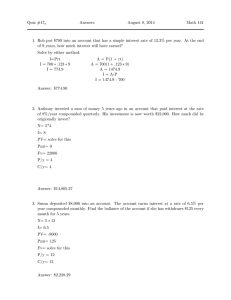
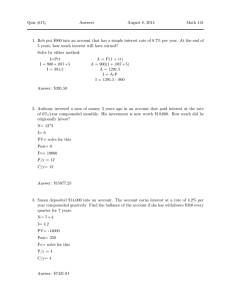
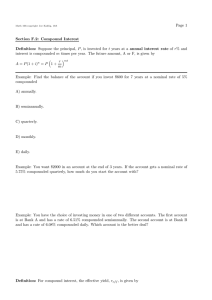
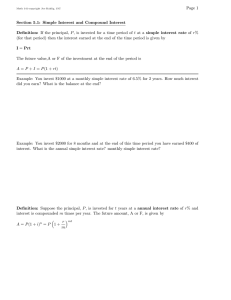
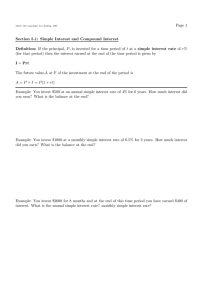


![Practice Quiz 6: on Chapter 13 Solutions [1] (13.1 #9) The](http://s3.studylib.net/store/data/008331662_1-d5cef485f999c0b1a8223141bb824d90-300x300.png)